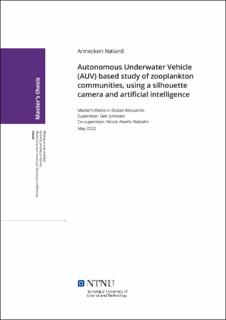| dc.contributor.advisor | Johnsen, Geir | |
| dc.contributor.advisor | Aberle-Malzahn, Nicole | |
| dc.contributor.author | Nøland, Annecken | |
| dc.date.accessioned | 2022-07-09T17:22:29Z | |
| dc.date.available | 2022-07-09T17:22:29Z | |
| dc.date.issued | 2022 | |
| dc.identifier | no.ntnu:inspera:101980170:23546075 | |
| dc.identifier.uri | https://hdl.handle.net/11250/3004408 | |
| dc.description.abstract | Autonome undervannsfarkoster (AUV), som kan tilpasses med en montert sensorpakke, har vist seg å være nyttige for økologistudier av plankton ved å gi kontinuerlige romlige og tidsmessige observasjoner over mesoskalaen. En annen ny metode er SilCam-bildesystemet, som tar bilder av objekter fordelt i vannsøylen in situ og deretter klassifiserer funnene. Når SilCam-systemet er montert på en AUV, kan in situ planktonbilder og nøkkelmiljøvariabler (KEVs) samles inn samtidig, hvilket kan bidra til en økt forståelse av de marine økosystemet.
Denne studien hadde som mål å vurdere hvordan denne nye metoden, som kombinerer en AUV og et SilCam, presterte i en studie av dyreplanktonsamfunnets sammensetning og tilhørende nøkkelmiljøvariabler, for å gi innsikt i variasjoner i tid og rom og planktondynamikk. Nyttigheten til SilCam-metoden ble også vurdert separat, og tok for seg ytelsen til to algoritmer som brukte kunstig intelligens (AI) i planktonklassifisering. Funnene tydet på at SilCam-metoden best fungerer som et tillegg til nettprøver, ettersom den foreløpig ikke tillater den høye taksonomiske oppløsningen som er muliggjort av nettprøver, på grunn av den lave optiske oppløsningen til SilCam. Den lave optiske oppløsningen, kombinert med et begrenset treningsdatasett, bidro også til en begrenset klassifiseringsnøyaktighet oppnådd av AI-algoritmene. AUV-en anskaffet et omfattende datasett av klorofyll a (som et mål for planktonalgebiomasse), havtemperatur, saltholdighet og oppløst oksygen. Likevel hadde sensorene forskjellige egenskaper, som responstid, prøvetakingsintervaller og kalibrering, noe som resulterte i utfordringer med å kombinere og sammenligne dataene.
Data fra AUV-sensorene, SilCam-systemet, vannprøver og verifisering med nettprøver ble kombinert for å vurdere tilstanden til våroppblomstring av planktonalger på Mausund og i Hopavågen i kystnære Trøndelag, Norge, som også var et av målene med studien. Gjennom denne kombinasjonen av informasjon ble det konkludert med at de to besøkene til Mausund ble gjort henholdsvis før og i løpet av en planktonalgeoppblomstring, og at Hopavågen ble besøkt etter en planktonalgeoppblomstring. Samlet sett belyste denne studien forbedringsområdene knyttet til denne metoden, men også dens potensiale til å være et svært verdifullt verktøy i fremtidige planktonstudier og dermed overvåking av klimaendringer i havet. | |
| dc.description.abstract | Autonomous Underwater Vehicles (AUVs), which can be customized with environmental sensors, have proven useful for plankton ecology studies by providing continuous spatial and temporal observations over the mesoscale. Another novel tool is the SilCam imaging system, which captures images of objects suspended in the water column in situ and classifies the findings. When mounted on an AUV, in situ plankton images and key environmental variables (KEVs) can be captured simultaneously, allowing for an increased understanding of the marine ecosystem.
This study aimed to assess how this novel method, combining an AUV and a SilCam system, performed in a study of zooplankton community composition and KEVs, for providing insights on spatiotemporal variations and plankton dynamics. The usability of the SilCam method was also assessed separately, addressing the performance of two artificial intelligence (AI) algorithms in plankton classification. The findings suggested that the SilCam method best serves as an addition to net samples, as it for now does not allow for the high taxonomic resolution enabled by net samples, due to the low optical resolution of the SilCam. The low optical resolution, combined with a limited training data set, also contributed to a limited plankton classification accuracy obtained by the AI algorithms. The AUV acquired an extensive data set of chlorophyll a (as a proxy for phytoplankton biomass), seawater temperature, salinity, and dissolved oxygen. Still, the sensors had different properties, such as response time, sampling intervals, and calibration, resulting in challenges with combining and comparing the data.
Data from the AUV sensors, SilCam system, and ground-truthing were combined to assess the state of the phytoplankton spring bloom conditions in Mausund and Hopavågen in coastal Trøndelag, Norway, as also was one of the aims of the study. Through this coupling of information, it was concluded that a phytoplankton pre-bloom and an ongoing bloom occurred on the first and second visit to Mausund, respectively, and that there was a post-bloom in Hopavågen. Overall, this study elucidated the areas of improvement related to sampling of plankton data using an AUV mounted with a SilCam imaging system, but also the method’s potential to be a very valuable tool in future plankton studies, and thereby the monitoring of climate change in the ocean. | |
| dc.language | eng | |
| dc.publisher | NTNU | |
| dc.title | Autonomous Underwater Vehicle (AUV) based study of zooplankton communities, using a silhouette camera and artificial intelligence | |
| dc.type | Master thesis | |
